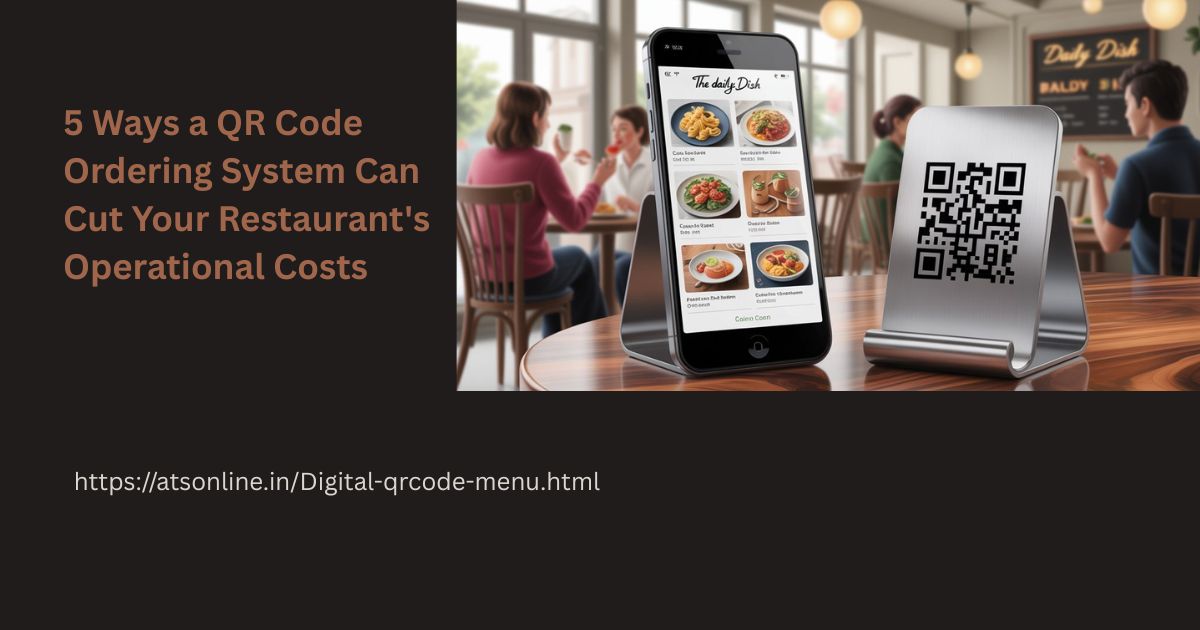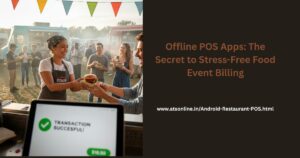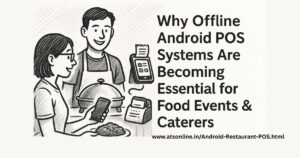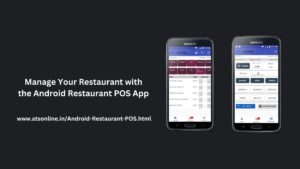Discover how a modern QR code ordering system can significantly lower your restaurant’s operational costs. Learn to reduce spending on printing, labor, and food waste for better profit margins.
For any restaurant owner, managing operational costs is a constant battle. Between rising food prices, labor challenges, and razor-thin profit margins, every rupee counts. While you can’t control the cost of ingredients, you can control how efficiently your restaurant runs. The key lies in leveraging smart technology designed to tackle your biggest expenses head-on.
A modern QR code ordering system is no longer a temporary trend; it’s a powerful business tool that directly improves operational efficiency. In this guide, we’ll break down five proven ways this technology can cut your restaurant’s operational costs and boost your bottom line.
First, What is a QR Code Ordering System & How Does it Work?
Before diving into the savings, let’s clarify what this technology is. A QR code ordering system allows your diners to scan a code at their table with their smartphone. This instantly opens your digital menu, where they can browse, order, and even pay securely. No app download is needed.
For the customer, it’s a seamless journey:
- Scan the code.
- Browse the visual, up-to-date menu.
- Order & Pay directly from their device.
For your restaurant, the order is sent instantly as a digital Kitchen Order Ticket (KOT) to the kitchen or your central terminal. This ensures 100% order accuracy every time, as the customer enters the order themselves.
The 5 Proven Ways a QR System Slashes Your Restaurant Operational Costs
Here are five specific areas where you will see a direct financial impact.
1. Eliminate Menu Printing Expenses Forever
Physical menus are a hidden but significant operational cost. Think about the expenses involved:
- Design Fees: Professional layout and design.
- Printing Costs: Large batches for lunch, dinner, and bar menus.
- Reprinting: For a single price change or new dish.
- Waste: Damage from spills and daily wear and tear.
A restaurant can easily spend ₹10,000 – ₹20,000 per year or more on menu-related costs.
A QR code ordering system makes this cost zero. With a digital menu, updates are instant and free. Did a supplier increase a price? Change it in seconds. Need to 86 a sold-out item? Remove it from the menu with a single click. This flexibility is a game-changer for menu engineering and cost control, making it the ultimate cheaper alternative to printing menus.
2. Optimize Staff Productivity to Lower Labor Costs
Labor costs are often a restaurant’s largest expense. A common fear is that technology will replace staff, but a QR system is designed to empower them. It automates the most routine, transactional parts of the job, allowing your team to focus on high-value hospitality.
Instead of running back and forth to take orders and process payments, your staff can focus on:
- Greeting guests warmly.
- Explaining specials and offering recommendations.
- Ensuring guest satisfaction and handling any issues.
- Turning tables faster.
By improving staff productivity, one server can efficiently manage a larger section, helping you manage restaurant labor costs effectively without sacrificing service quality.
Case Study: A mid-size casual dining restaurant found that after implementing a QR system, their servers could handle 30% more tables during peak hours, significantly boosting revenue without needing to hire additional staff.
3. Minimize Costly Errors to Reduce Food Waste
A single misheard order—”extra bacon” instead of “no bacon”—sets off a costly chain reaction:
- Wasted Food: The incorrect dish is thrown out.
- Doubled Cost: The kitchen has to re-fire the order.
- Lost Time: The kitchen workflow is disrupted.
- Unhappy Customer: Their meal is delayed.
This directly impacts your food costs and profit margins. A QR ordering system acts as the ultimate software to prevent restaurant order mistakes. Because the customer inputs their own order, including special requests, order accuracy is guaranteed. This simple change is one of the most effective ways to reduce restaurant food waste.
4. Increase Table Turnover Rate & Average Order Value (AOV)
Faster service means more customers served per day. Your system improves the table turnover rate by eliminating the biggest bottlenecks in the dining process:
- No Waiting to Order: Guests order the moment they’re ready.
- Easy Re-ordering: Want another drink? It’s just a few taps away.
- Instant Payment: Guests can pay and leave whenever they wish, freeing up the table for the next party.
Furthermore, a digital menu is a powerful sales tool. You can increase your Average Order Value (AOV) by using proven menu engineering techniques.
| Feature | Impact on AOV |
| High-Quality Photos | Enticing visuals make customers order more. |
| Automated Upsells | “Make it a large?” or “Add a side?” prompts. |
| Featured Items | Place high-margin items at the top of the menu. |
This combination of speed and smart selling ensures you are maximizing the revenue from every single table.
5. Leverage Data for Smarter Inventory Management
Knowledge is power, especially when it comes to inventory. A QR system tracks every item sold, giving you clear data on what’s popular and what’s not. This data is crucial for smart inventory management.
Instead of guessing, you know exactly which ingredients to stock up on and which to reduce, minimizing spoilage and waste. This data also fuels your menu engineering, allowing you to refine your offerings based on real performance. This data-driven approach ensures a fast Return on Investment (ROI) by turning your ordering system into a business intelligence tool.
Conclusion: A Smart Investment in Your Restaurant’s Future
Adopting a QR code ordering system is no longer just about being modern; it’s one of the most strategic moves you can make to control your restaurant operational costs. By eliminating printing expenses, optimizing labor, guaranteeing order accuracy, increasing table turnover, and providing valuable data, this technology provides a clear and rapid Return on Investment (ROI).
Ready to take control of your restaurant’s costs?
Book a Free Demo of the ATS Online QR Ordering System today and get a personalized analysis of how much you can save!
You can reach us by phone at +91 9810078010 or by email at ats.fnb@gmail.com. Thank you for your interest in our services.
FAQs
1. Is a QR code ordering system worth it for a small restaurant or cafe?
Absolutely. A QR code ordering system is especially valuable for smaller establishments. It helps you run a leaner operation by reducing the need for extensive front-of-house staff, completely eliminates the recurring cost of printing menus, and ensures every order is perfectly accurate, which cuts down on expensive food waste. This allows you to maximize your profit margins even with lower volume.
2. Will a digital ordering system feel impersonal and hurt my guest experience?
It’s actually the opposite. By automating the routine tasks of taking orders and payments, a QR system frees up your staff to focus on what truly matters: hospitality. They can spend more quality time with guests, offer personal recommendations, and ensure everyone is having a wonderful experience, rather than just acting as order-takers.
3. Does this system work for both restaurant table service and hotel room service?
Yes, our system is designed to be highly flexible for both environments. For restaurants, it streamlines table ordering and payment. For hotels, it modernizes the guest experience by enabling digital in-room dining, poolside ordering, and even requests for amenities like extra towels or spa bookings, all from the guest’s own phone.
4. What do my customers need to use the QR code ordering system?
All your customers need is a smartphone with a camera—that’s it. There are no apps to download and no complicated sign-up processes. They simply scan the QR code, and your menu instantly opens in their phone’s web browser, making it incredibly simple and accessible for everyone.
5. How does this system integrate with my existing restaurant POS?
Our QR ordering system is designed as a powerful, stand-alone application that works seamlessly alongside your existing POS. It acts as a dedicated order collection point, sending clear, accurate orders to your kitchen or bar for processing. This setup avoids complex and costly POS integration issues while still providing a complete digital ordering solution.
6. What happens if my business’s internet connection goes down?
We understand that reliable operation is critical. While a stable internet connection is best, many systems have fail-safes. Depending on the setup, orders can be queued and processed once the connection is restored, or you can have a backup cellular data plan. We can discuss the best contingency plan for your specific business to ensure you’re never down during peak hours.




